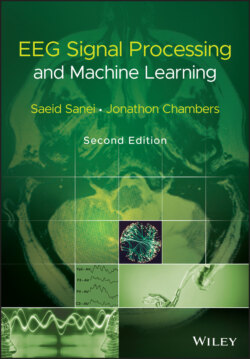Читать книгу EEG Signal Processing and Machine Learning - Saeid Sanei - Страница 22
2.2 EEG Recording and Measurement
ОглавлениеAcquiring signals and images from the human body has become vital for early diagnosis of a variety of diseases. Such data can be in the form of electrobiological signals such as electrocardiogram (ECG) from the heart, electromyography (EMG) from muscles, electroencephalography (EEG) from the brain, magnetoencepalogram (MEG) from the brain, electrogastrography (EGG) from the stomach, and electro‐oculography (electro‐optigraphy, EOG) from eye nerves. Measurements can also have the form of one type of ultrasound or radiograph such as sonograph (or ultrasound image), computerized tomography (CT), magnetic resonance imaging (MRI) or functional MRI (fMRI), positron emission tomography (PET), and single photon emission tomography (SPET).
Figure 2.2 Different waveforms that may appear in the EEG while awake or during sleep periods.
Functional and physiological changes within the brain may be registered by either EEG, MEG, or fMRI. Application of fMRI is however very limited in comparison with EEG or MEG due to a number of important reasons:
1 The time resolution of fMRI image sequences is very low (for example approximately two frames per second), whereas complete EEG bandwidth can be viewed using EEG or MEG signals.
2 Many types of mental activities, brain disorders, and mal functions of the brain cannot be registered using fMRI since their effect on the level of oxygenated blood is low.
3 The accessibility to fMRI (and currently to MEG) systems is limited and costly.
4 The spatial resolution of EEG however, is limited to the number of recording electrodes (or number of coils for MEG).
The first electrical neural activities were registered using simple galvanometers. In order to magnify very fine variations of the pointer a mirror was used to reflect the light projected to the galvanometer on the wall. The d'Arsonval galvanometer later featured a mirror mounted on a movable coil and the light focused on the mirror was reflected when a current passed the coil. The capillary electrometer was introduced by Marey and Lippmann [12]. The string galvanometer, as a very sensitive and more accurate measuring instrument, was introduced by Einthoven in 1903. This became a standard instrument for a few decades and enabled photographic recording.
More recent EEG systems consist of a number of delicate electrodes, a set of differential amplifiers (one for each channel) followed by filters [9], and needle (pen) type registers. The multichannel EEGs could be plotted on plane paper or paper with a grid. Soon after this system came to the market, researchers started looking for a computerized system, which could digitize and store the signals. Therefore, to analyze EEG signals it was soon understood that the signals must be in digital form. This required sampling, quantization, and encoding of the signals. As the number of electrodes grows the data volume, in terms of the number of bits, increases. The computerized systems allow variable settings, stimulations, and sampling frequency, and some are equipped with simple or advanced signal processing tools for processing the signals.
The conversion from analogue‐to‐digital EEG is performed by means of multichannel analogue‐to‐digital converters (ADCs). Fortunately, the effective bandwidth for EEG signals is limited to approximately 100 Hz. For many applications this bandwidth may be considered even half of this value. Therefore, a minimum frequency of 200 Hz (to satisfy the Nyquist criterion) is often enough for sampling the EEG signals. In some applications where a higher resolution is required for representation of brain activities in the frequency domain, sampling frequencies of up to 2000 samples per second may be used.
In order to maintain the diagnostic information the quantization of EEG signals is normally very fine. Representation of each signal sample with up to 16 bits is very popular for the EEG recording systems. This makes the necessary memory volume for archiving the signals massive, especially for sleep EEG and epileptic seizure monitoring records. However, in general, the memory size for archiving the images is often much larger than that used for archiving the EEG signals.
A simple calculation shows that for a one hour recording from 128‐electrode EEG signals sampled at 500 samples per second a memory size of 128 × 60 × 60 × 500 × 16 ≈ 3.68 Gbits ≈ 0.45 Gbyte is required. Therefore, for longer recordings of a large number of patients there should be enough storage facilities such as in today's technology Zip disks, CDs, large removable hard drives, and optical disks.
Although the format of reading the EEG data may be different for different EEG machines, these formats are easily convertible to spreadsheets readable by most signal processing software packages such as MATLAB.
The EEG recording electrodes and their proper function are crucial for acquiring high quality data. There are different types of electrodes often used in the EEG recording systems as:
disposable (gel‐less, and pre‐gelled types)
reusable disc electrodes (gold, silver, stainless steel, or tin)
headbands and electrode caps
saline‐based electrodes
needle electrodes.
For multichannel recordings with a large number of electrodes, electrode caps are often used. Commonly used scalp electrodes consist of Ag–AgCl discs, less than 3 mm in diameter, with long flexible leads that can be plugged into an amplifier. Needle electrodes are those which have to be implanted under the skull with minimal invasive operations. High impedance between the cortex and the electrodes as well as the electrodes with high impedances can lead to distortion, which can even mask the actual EEG signals. Commercial EEG recording systems are often equipped with impedance monitors. To enable a satisfactory recording the electrode impedances should read less than 5 kΩ and be balanced to within 1 kΩ of each other. For more accurate measurement the impedances are checked after each trial.
Due to the layered and spiral structure of the brain, however, distribution of the potentials over the scalp (or cortex) is not uniform [13]. This may affect some of the results of source localization using the EEG signals.
